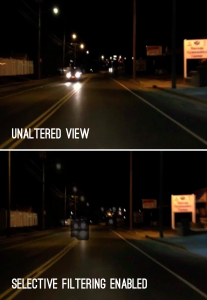Thesis Showcase: Thom Hines Re-envisions Augmented Reality Design
In this series, second-year D&T MFA students explain what they are doing with their thesis projects, where they apply what they’ve been learning toward their personal interests. Below, Thom Hines–who recently got exciting news that he is going to become a professor of interaction design at Portland State University next fall–explains why he’s designing his own version of an augmented reality interface. By Rachel Signer.
What’s the main idea of your project?
It takes a critical view of augmented reality. Instead of using overlays and data to convey extra information to people, I’m trying to simplify the user vision in a way that allowed them to focus on what’s around them, and simplify what they see so they are focused more on real reality. It manifests in the form of a car windshield that, through the use of transparent LCD technology will make certain portions of the driver’s vision dim in order to compensate for headlights shining in the driver’s eyes, kind of like the autofocus on a camera. I’m designing the interface for how an augmented reality experience should be. Over the last twenty years, ‘augmented reality’ has become more and more a futuristic view on how we might interface with our environments—through the use of glasses or screens overlaying information on top of what we might normally see. One of the earliest examples was Terminator vision, where he was able to see data based on who he was looking at.
What was the design process like?
I’ve worked through a series of prototypes. At first I wanted to work on an augmented reality app, where I interrogated what the value of augmented reality was. But after two months of that, I realized that augmented reality has some useful applications, but in a daily experience context, it made things more complex instead of simpler. So I rejected the idea that augmented reality can be an everyday, all-the-time experience. From there, I did some prototypes on the iPad looking at how people interact with virtual and real objects that are mediated by some sort of transparent device. The iPad makes it seem like you’re looking through a window. By examining that, I was led toward the idea of what I’m calling ‘selective reality,’ which is much more about user choice and user control, rather than providing different buttons and ways of interacting with only virtual things.
Does your project have a business model or plan for moving forward?
The idea of applying it to a car windshield is something I’d like to pursue, either through partner with car companies or display makers. I’d like to apply my research in a car setting where we might actually benefitting people on the roads, by providing a better, safer, more comfortable driving experience.
What has been the most challenging aspect of your project?
The technology that’s being developed for the transparent LCD screens is very new and it’s not commercially available, nor is it cheap. I’ve had to make really rough approximations. Last semester, I made a prototype where I disassembled an old LCD computer monitor and took apart the display portion, and that’s a mostly clear piece of glass with all the pixels built in. unfortunately it’s too dark to be used in a windshield. But it’s allowed me to play with what happens when you do have pixels and someone needs to look through the, and beyond them. Unfortunately, for the demonstration of my project I will only be able to simulate the experience, instead of actually showcasing the screen, because the technology was too difficult to access. I’ve got things figured out more on the software side, though.
What surprised you while you were working on it?
The importance of context. I didn’t necessarily frame my ideas the way I am now, with as many details. It was one thing to explain the concept when it didn’t have a specific setting and I couldn’t demonstrate it in a way people could experience more personally. Over the last three months I’ve been moving toward making it a more visual and graspable experience, so it’s less abstract.
How has this program been supportive to your project?
Technically, I’ve learned most of the skills I’m applying to this project at Parsons—the code, the hardware, even how I’ve been able to present these things. These are fairly new skills for me, and wouldn’t have been possible in a less technologically-centered program. Also, I’ve had ideas like this one for a number of years, but they didn’t have as much importance as I feel this one does now, because I’ve had to think really critically here about what it is I’m presenting here. The faculty here, not only in thesis but all my classes, led me to really question my choices and think of new ideas and push the possibilities of what I can do beyond what I ever dreamed possible before.


